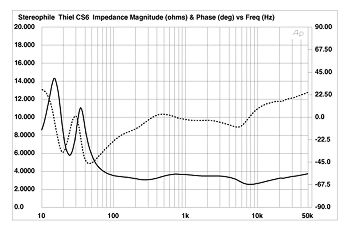| Columns Retired Columns & Blogs |
Thiel CS6 Loudspeaker Measurements
Sidebar 3: Measurements
My estimate of the CS6's B-weighted sensitivity was a little higher than specified, at 88dB/2.83V/1m. As is typical of Jim Thiel designs, however, the CS6's impedance is low; fig.1 reveals that it stays below 4 ohms over almost the entire audio band, and drops to a minimum value of 2.54 ohms at 8kHz. As is also typical of Jim Thiel speakers, the electrical phase angle is low as well, reducing the effect of the CS6's low impedance on the partnering amplifier. Like a reflex port, the tuning of the passive radiator is revealed by the "saddle" in the magnitude curve at 25Hz, implying excellent low-bass extension. Other than a very slight wrinkle at 22kHz in the traces (probably not visible at the scale at which this graph must be published in the magazine) that is associated with the metal-dome tweeter's ultrasonic and innocuous "oil-can" mode, fig.1 is free from resonance-induced effects. This implies rigid, well-braced cabinet construction.

Fig.1 Thiel CS6, electrical impedance (solid) and phase (dashed) (2 ohms/vertical div.).
Fig.2 shows the individual responses of the passive radiator, woofer, and midrange units, measured in the nearfield, with each unit's level adjusted to compensate for its different radiating diameter. The radiator's output can be seen to peak at a low 28Hz, this almost coincident with the woofer's minimum-motion point. The woofer basically covers the decade from 40Hz to 400Hz, with the crossover to the midrange starting around 350Hz. The midrange rollout is gentle, which is why high-amplitude, low-frequency signals resulted in visible midrange-cone motion.

Fig.2 Thiel CS6, nearfield responses of midrange, woofer, and passive radiator responses plotted below 1kHz.
Measuring the frequency response of a large system using a first-order crossover without access to a large anechoic chamber is fraught with difficulty: the drive-units don't really integrate closer than 10' or so, yet it is very hard to get that far back and take a meaningful measurement. Fig.3 shows the CS6's response on its tweeter axis, averaged across a 30-degree horizontal window. Other than a suckout in the upper midrange on this axis at this distance, and apparent excesses of energy above 9kHz and below 120Hz, the balance is quite neutral. The bass plateau is at least partly due to the nearfield measurement technique, and doesn't obscure the fact that the CS6 offers excellent LF extension: -6dB at a low 26Hz. The shape of the curve in the top octave is presumably due to the acoustic loading effect of the midrange cone on the tweeter's output, but this is minor. The speaker certainly didn't sound fizzy or tilted-up.

Fig.3 Thiel CS6, anechoic response on tweeter axis at 50", averaged across 30 degrees horizontal window and corrected for microphone response, with the complex sum of midrange, woofer, and passive radiator responses plotted below 300Hz.
- Log in or register to post comments




































